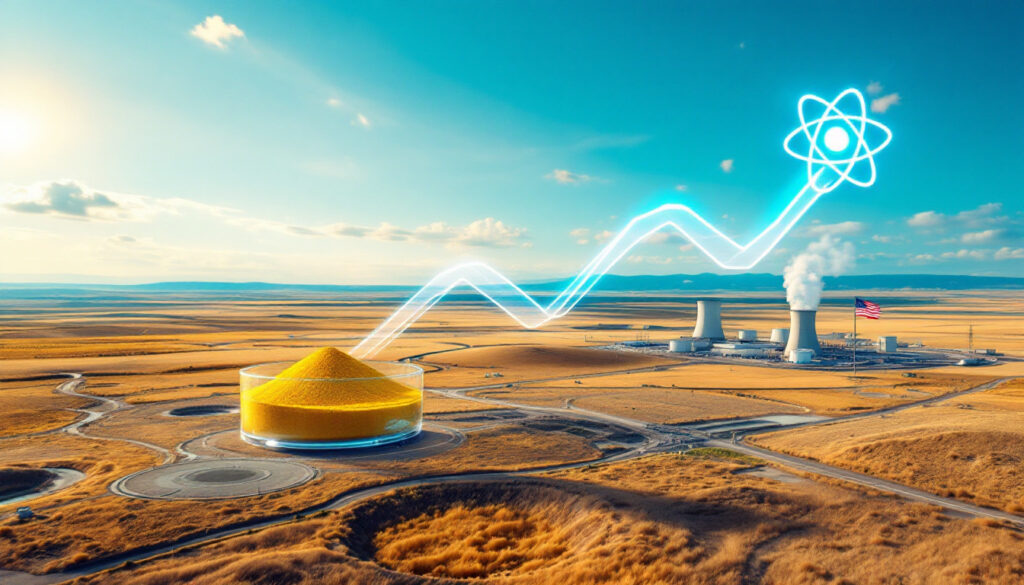US Uranium Production Reaches Six-Year High in 2024
The Resurgence of US Uranium Production
The United States has witnessed a remarkable revival in its domestic uranium production, with output reaching levels not seen since 2018. This resurgence marks a pivotal moment for the nation's nuclear energy sector and highlights shifting priorities in energy security and supply chain resilience.
Record-Breaking Q4 Production Figures
The fourth quarter of 2024 delivered exceptional results for America's uranium industry, with production of uranium concentrate reaching an impressive 375,401 pounds. This quarterly figure is particularly significant as it exceeds the total annual production for each of the three previous years—2021, 2022, and 2023—according to data from the Energy Information Administration (EIA).
The dramatic increase becomes even more apparent when comparing consecutive quarters. Q4 production more than tripled the Q3 2024 output of 121,296 pounds, representing the highest quarterly production level in six years. This acceleration indicates not merely a temporary spike but potentially a sustained recovery in domestic uranium capabilities.
"The industry is experiencing a renaissance driven by multiple factors including favorable economics, strategic policy initiatives, and renewed interest in nuclear energy's role in addressing climate change," notes Dr. Sarah Johnson, nuclear energy analyst at the Energy Policy Institute.
Key Production Facilities Contributing to Growth
The White Mesa Mill in Utah, owned by Energy Fuels Inc., has played a crucial role in this production surge. As the only conventional uranium mill currently operating in the United States, its resumption of operations represents a significant milestone for domestic processing capabilities.
Beyond Utah, the primary production sources were two in-situ recovery (ISR) processing facilities located in Texas and Wyoming. In fact, Peninsula Energy restarts uranium production in Wyoming has been a critical development in revitalizing the domestic supply chain. These operations utilize a less invasive mining technique where solutions are injected into uranium deposits to dissolve the mineral, which is then pumped to the surface for processing.
The limited number of active facilities—just three major production centers across the entire country—highlights the concentration risk in the domestic uranium supply chain. This concentration underscores both the vulnerability and importance of these facilities to national energy security.
Driving Factors Behind Production Increase
Market Conditions Supporting Uranium Growth
Uranium prices have experienced a significant upward trajectory, creating favorable economics for domestic production. Spot prices reached approximately $75 per pound in early 2024, representing a substantial increase from the $30-$40 range seen in recent years.
"We're witnessing the uranium market response to years of underinvestment," explains Michael Davidson, commodities strategist at Resource Capital Research. "The price floor has shifted upward as nuclear utilities secure long-term supplies amid growing concerns about future availability."
This price environment has improved the financial viability of U.S. production facilities that were previously unable to compete with lower-cost foreign imports. Additionally, growing demand from the nuclear energy sector has created a more sustainable market for domestically produced uranium.
Nuclear power's role as a reliable, carbon-free baseload energy source has gained renewed appreciation amid intensifying efforts to reduce greenhouse gas emissions while maintaining grid stability. Understanding 2024 uranium market trends & geopolitical shifts provides essential context for this production increase.
Government Support for Domestic Uranium Industry
In late 2023, the federal government provided significant support to the uranium industry by offering contracts to six companies to produce high-assay, low-enriched uranium (HALEU) fuel. This initiative, part of the $2.7 billion Nuclear Fuel Security Program, represents a strategic move to revitalize the domestic uranium supply chain.
"These contracts signal a fundamental shift in U.S. energy policy," notes former Department of Energy official James Harrison. "After decades of allowing domestic uranium production to decline, we're seeing concrete steps to rebuild this critical industry."
The policy focus extends beyond just raw uranium production to encompass the entire fuel cycle, including conversion and enrichment capabilities. This comprehensive approach aims to reduce American dependence on imported uranium, particularly from regions that may present geopolitical risks.
Why Is Nuclear Energy Gaining Renewed Interest?
Growing US Electricity Demand
The United States faces unprecedented growth in electricity demand, creating new opportunities for nuclear power. Data centers alone are projected to consume up to 7-8% of total U.S. electricity by 2030, up from roughly 2-3% today.
"The digital economy's energy requirements are exploding," observes Dr. Elena Rodriguez, power systems researcher at MIT. "A single hyperscale data center can consume as much electricity as a small city, and these facilities need 24/7 reliability that nuclear can provide."
Beyond tech infrastructure, manufacturing reshoring initiatives are creating additional industrial power demand. New semiconductor fabs, battery plants, and other advanced manufacturing facilities require significant baseload power that can't be interrupted.
The electrification of transportation and buildings further compounds this trend, with electric vehicles and heat pumps transforming electrical consumption patterns. The Department of Energy estimates these factors could drive a 10-15% increase in total U.S. electricity demand by 2030.
Nuclear power, with its reliability and capacity factors exceeding 90%, is increasingly positioned as an essential component of the future grid. Unlike intermittent renewable sources, nuclear plants provide consistent baseload generation regardless of weather conditions.
Nuclear Revival Projects
Several ambitious projects aim to breathe new life into America's nuclear infrastructure. Companies are attempting to restart two fully shut nuclear reactors that had previously been decommissioned, representing a shift from the retirement trend that dominated the past decade.
One of the most notable initiatives includes plans to revive a reactor at the former Three Mile Island facility in Pennsylvania. This site, infamous for its 1979 accident, could paradoxically become a symbol of nuclear's resurgence if successful.
Constellation Energy, formerly Exelon, is leading efforts to restore operations at its Byron and Dresden plants in Illinois, while TerraPower and X-energy are advancing next-generation reactor designs with support from the Advanced Reactor Demonstration Program.
"We're not just maintaining existing nuclear capacity—we're actively working to expand it," states William Davidson, CEO of American Nuclear Partners. "The appetite for new nuclear projects is stronger than it's been since the 1970s."
The Broader Uranium Market Context
Global Uranium Market Dynamics
Recent market disruptions have highlighted vulnerabilities in the global uranium supply chain. Market freezes related to potential U.S. tariff threats against Russian uranium imports created significant price volatility throughout 2023 and early 2024.
Kazakhstan, which produces approximately 40% of the world's uranium, faced production challenges due to transportation disruptions and regional instability. Canadian producer Cameco experienced flooding at its Cigar Lake mine, further tightening global supply.
"The uranium market has transformed from a buyer's market to a seller's market almost overnight," explains uranium market analyst Susan Chen. "Utilities that were complacent about fuel security are now scrambling to secure long-term supplies."
These supply chain vulnerabilities, exposed by geopolitical tensions and production disruptions, have created both challenges and opportunities for U.S. producers. The price volatility has improved the economics of domestic production while highlighting the risks of over-reliance on foreign sources.
Understanding the comprehensive guide to global uranium deposits & production is essential for contextualizing how the US produces most uranium since 2018 within the broader international landscape.
Strategic Importance of Domestic Production
The national security implications of uranium supply have become increasingly apparent to policymakers. Nuclear power generates approximately 20% of U.S. electricity, making fuel security an essential component of critical infrastructure protection.
The Russian invasion of Ukraine catalyzed concerns about dependence on Russian uranium, which previously supplied about 14% of U.S. reactor fuel needs. According to recent EIA data, sanctions against Russian nuclear conglomerate Rosatom have further complicated international supply chains.
"Uranium isn't just another commodity—it's a strategic resource with direct implications for national security and energy independence," argues former National Security Council member Dr. Robert Williams. "Domestic production capabilities represent a form of energy sovereignty."
Building resilience in critical mineral supply chains has emerged as a bipartisan priority. The 2022 Inflation Reduction Act and the CHIPS and Science Act both included provisions supporting domestic uranium production and nuclear fuel cycle capabilities. For investors, understanding uranium mining market analysis and investment strategies has become increasingly important.
FAQ About US Uranium Production
What is uranium concentrate and how is it used?
Uranium concentrate, commonly known as yellowcake due to its yellowish appearance, is processed uranium ore containing approximately 80% uranium oxide (U₃O₈). This intermediate product represents the first major processing step after uranium is extracted from the ground.
The primary use of uranium concentrate is as fuel for nuclear reactors generating electricity. However, before it can be used in reactors, yellowcake must undergo several additional processing steps:
- Conversion to uranium hexafluoride (UF₆)
- Enrichment to increase the concentration of the U-235 isotope
- Fabrication into fuel pellets and assemblies
Once processed into fuel assemblies, uranium powers nuclear reactors through controlled fission reactions, producing heat that generates steam to drive turbines and create electricity without carbon emissions.
How does current US uranium production compare to historical levels?
Current production represents a significant recovery but remains well below peak historical levels. In the 1980s, U.S. uranium production exceeded 40 million pounds annually, nearly 100 times greater than recent years' output.
The Q4 2024 production milestone of 375,401 pounds marks the highest quarterly production since 2018, signaling a potential turnaround after years of decline. However, domestic production still meets only a fraction of U.S. uranium needs, with approximately 90% of uranium still sourced from international suppliers.
"We're seeing the beginning of a recovery, not yet a renaissance," cautions industry veteran Thomas Wilson. "Reaching self-sufficiency would require sustained investment over many years and significantly higher production levels."
The decline in U.S. uranium production over the past four decades reflects both economic challenges and shifting global supply chains, with Kazakhstan, Canada, and Australia emerging as dominant global producers offering lower-cost supplies. For those considering investment, exploring uranium investment strategic opportunities can provide valuable guidance.
What are the environmental considerations for uranium production?
Modern uranium mining employs various techniques with different environmental implications. In-situ recovery (ISR), the predominant method in the U.S., involves injecting oxygenated solutions underground to dissolve uranium, which is then pumped to the surface.
ISR generally creates less surface disturbance than conventional mining but requires careful groundwater monitoring and restoration. The EPA and state agencies enforce strict regulatory frameworks governing groundwater protection, radiation safety, and site remediation.
"Today's uranium production methods bear little resemblance to practices from the 1950s and 60s," explains environmental engineer Dr. Margaret Chen. "Modern operations incorporate advanced monitoring technologies and remediation protocols designed to minimize impacts."
Legacy issues from historical uranium mining, particularly on tribal lands in the American Southwest, remain a significant concern. The Abandoned Mine Lands program addresses remediation requirements for former uranium production sites, with several billion dollars allocated to cleanup efforts.
How might uranium production trends evolve in coming years?
The potential for continued growth in domestic uranium production depends on several interconnected factors. If nuclear power expansion continues as projected—with small modular reactors (SMRs) and microreactors nearing commercialization—demand for uranium will likely increase substantially.
Government policies and incentives will play a crucial role in production economics. The recently established uranium reserve program, which authorizes the Department of Energy to purchase domestically produced uranium, provides a guaranteed market that could stimulate additional production.
"The industry's trajectory will be shaped by the intersection of policy support, market dynamics, and technological innovation," predicts energy economist Dr. Jonathan Zhang. "Companies with permitted but inactive projects are watching these developments closely before making investment decisions."
International market dynamics and geopolitical factors will continue to influence domestic production decisions. Russian export restrictions, Kazakhstan's production stability, and Australia's expansion plans all factor into the global supply-demand balance that ultimately determines uranium prices.
As nuclear power gains recognition for its role in clean energy transitions, uranium's status as a critical mineral may further elevate the priority of domestic production capabilities in national resource strategies. According to the World Nuclear Association, this renewed focus on US uranium production represents a significant shift in the global nuclear fuel landscape.
Ready to Stay Ahead of Major Mineral Discoveries?
Discover significant ASX mineral discoveries as they happen with Discovery Alert's proprietary Discovery IQ model, turning complex data into actionable insights for investors. Explore our dedicated discoveries page to understand how major mineral findings can lead to exceptional market returns, and begin your 30-day free trial today.




